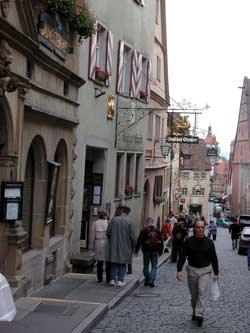The bus leaves in about 5 minutes for the 90-minute drive back to Wuerzberg. We’ve had another delightful day in Rothenberg. The first time I was here was in the early 1970’s with Gordon Plummer,  who was my boss back then. He had heard about this walled city and we drove over here from Munich one Saturday afternoon. I don’t remember much from that visit other than the walls and a new St. Martins Church. I haven’t found the church since then (but I haven’t looked too hard) but the walls are still here.
who was my boss back then. He had heard about this walled city and we drove over here from Munich one Saturday afternoon. I don’t remember much from that visit other than the walls and a new St. Martins Church. I haven’t found the church since then (but I haven’t looked too hard) but the walls are still here.
The last time we were here we stopped at McDonalds for the restroom (there is always a clean, western toilet in a McDonalds). That place is now gone! I don’t know whether or not the restriction on buildings and allowable modifications (McDonalds was not able to display any “Golden Arches” on the outside of the restaurant) or just poor business conditions, but the restaurant is closed. There is no more McDonalds in Rothenberg!
The shopping was just as good, if not better, than it was in 1999. Nina shipped a whole bunch of stuff home and we’ll need to figure out how to send more as we don’t have room (or weight). I took a couple hundred pictures. Maybe I can make something from all the pictures?? I brought both my 35mm camera as well as the digital camera. I used the film camera in Budapest and found it too cumbersome, particularly when I can’t see what I’ve taken to decide if I need to take another one.
in the early 1950’s a group of 16 German towns along the Mainz and Tauber rivers banded together and formed the “Romantisces Strasse” organization. They pooled money for marketing with the intent of bringing tourism to the area. They built bicycle paths along the rivers, put signs up along the way, put together advertising for hotels and restaurants, and a very effective marketing program. The Japanese just love the idea and come by the hundreds if not thousands. They copied the idea and have established a “Romantisches Strasse” near Mt. Fuji in Japan. That association paid for putting Japanese language signs along the route in Germany and I think that every Japanese tour bus goes along this road. I think it represents one of the most effective marketing programs in Europe, as tourism is the number one money producer for the region with wine ranking number two. I’m sure that the tourism helps enormously with the sale of wine.
Rothenburg is also known as "Christmas Town" as one of the major businesses in town is a year-round Christmas Store, Kaethe Wolfart. When we were in town in 1999 we spent a significant amount of money on Christmas tree ornaments. We did the same this time. Kaethe Wolfart has been able to extract a lot of money from our wallet — but all for a good cause. Another reason we like this town is that good quality souvenir products are available from all over southern German. There are enough tourists that quality merchandise has a good market in the city. I suspect that during the summer, the population doubles every day with all the tourists that arrive, spend money, and then leave.